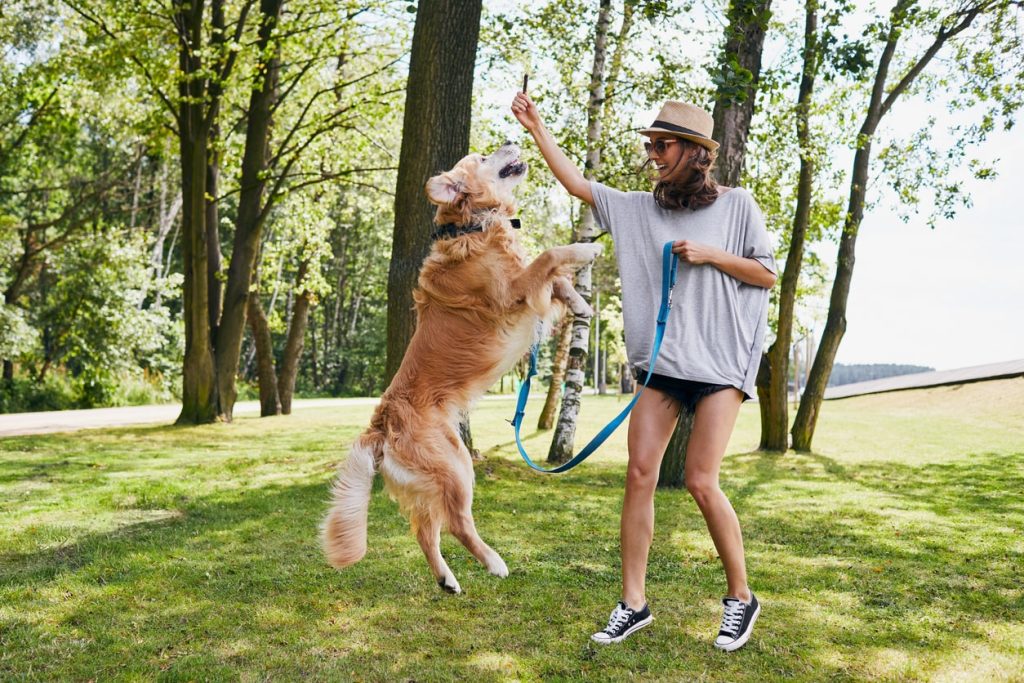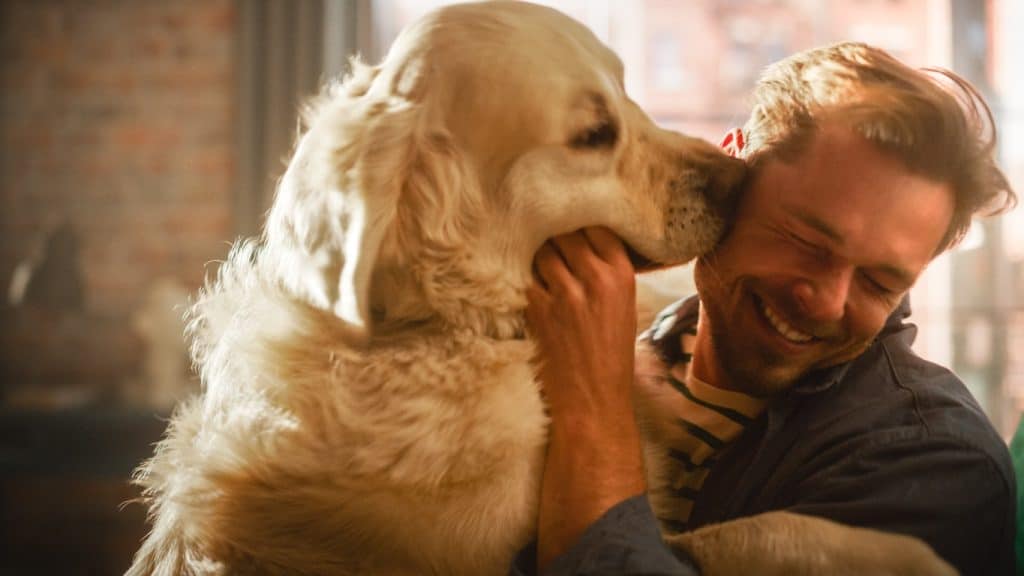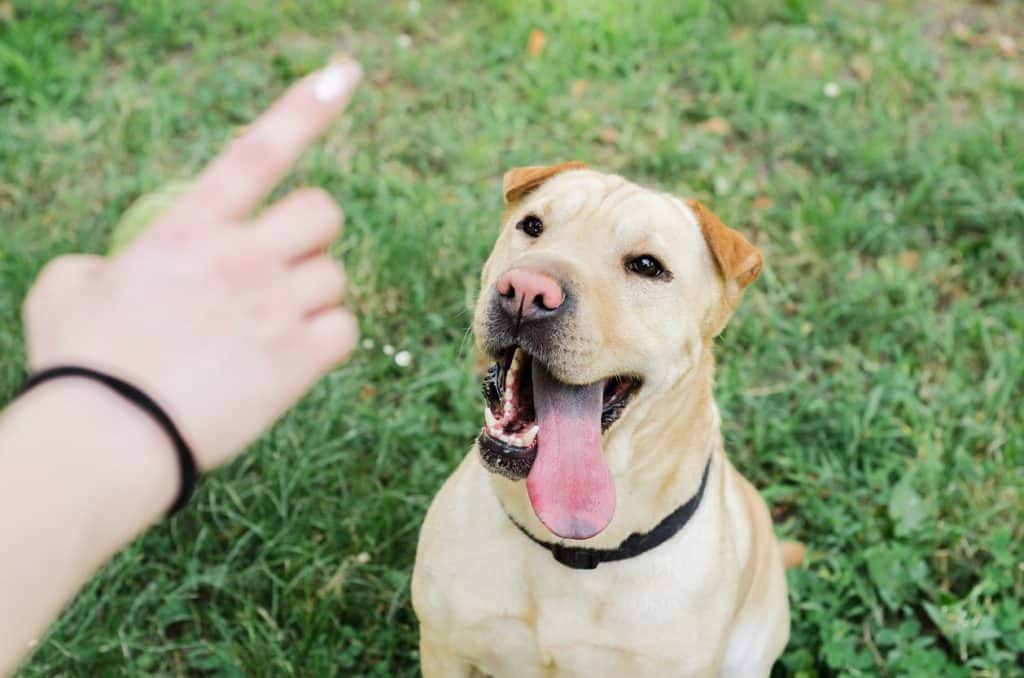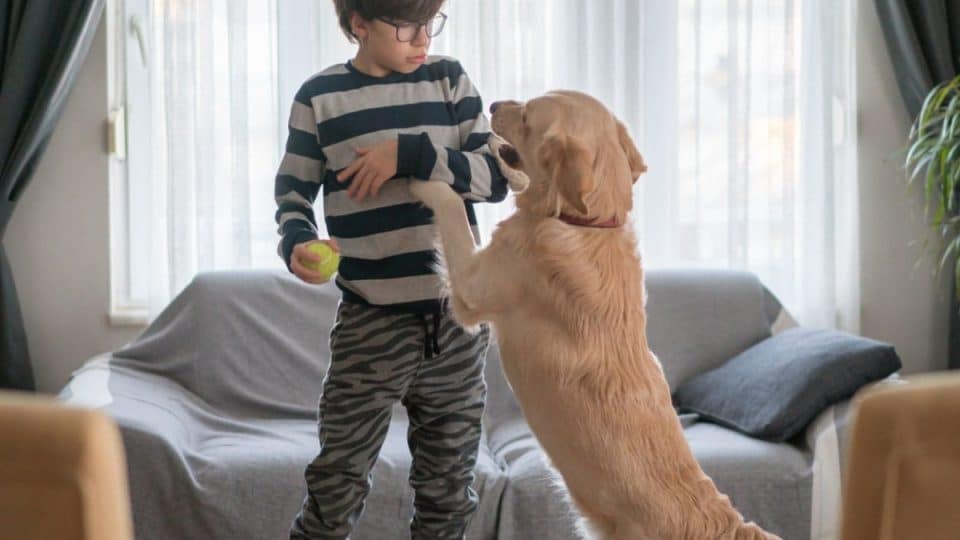If you have a dog who jumps on you and others, you are not alone! Around 56% of dog pet parents said their dogs regularly jump on them and others. With it being a widespread dog behaviour, it’s a good idea to know what causes your dogs to jump up. Steve Dale, CABC, a pet expert for over 20 years, notes the most common reasons dogs jump on you include:
- greeting you or your guests
- excitement
- attention seeking
- jumping out of aggression or fear
Below, we’ll explore why dogs jump, when it becomes a problem, and the best training methods to curb dog jumping.
4 Reasons Your Dog’s Jumping On You & Guests
We love our dogs, and one of their most endearing, sometimes frustrating, behaviours is their penchant for jumping. Dale outlines the most common reasons canines like to jump below.
They’re saying hello
One of the most common reasons why dogs jump is to say hello. Dale explains that dogs greet each other and us by saying ‘hi’ face-to-face. “Dogs can only see us face-to-face if they jump up,” he says.
Since one of the many ways dogs show us affection is by licking our faces, is it any wonder they want to jump up and say hello face-to-face too?

iStock/BartekSzewczyk
They’re excited
Dale explains nearly all dogs who jump are excited. Common reasons why dogs jump out of excitement include the following:
- you or another family member are returning home
- a new guest is entering the home
- food or treats
- you’re playing with them
- they’re ready for their daily walk
They’re seeking attention
One of the best ways to get someone’s attention is by jumping on them! Though we humans can’t get away with this behaviour, our dogs have realised this is one of the best ways to get our attention.
Some dogs are hungry and attempting to communicate this to us. Other times, they may tell us they need to go to the bathroom.
They’re acting aggressive
In some cases, dogs aggressively jump on people. Dale explains that most aggression is fear-based and advises dog parents to read their dog’s body language for signs of fear during the jumping. Research into human-directed dog aggression found that dogs were more likely to be aggressive toward unfamiliar people than their own family members.
If you suspect your dog is lunging out of aggression, Dale advises you to consult a positive reinforcement dog trainer, certified animal behaviour consultant, or veterinary behaviourist.
Dogs will never jump on you or anyone else to show dominance. They are not motivated to dominate other humans.

iStock/gorodenkoff
When Is Dog Jumping A Problem?
Let’s face it, a dog jumping on someone is never ideal. Apart from getting muddy paw prints over everyone’s clothes, it can be dangerous in some scenarios.
Your dog cannot tell whether the person they are about to bounce on will topple over. This can lead to them knocking over children and, in the worst cases, older adults.
Even a small dog jumping up can be hazardous. Dale notes that small dogs acting as jumping beans will unknowingly trip people.
What to Do When a Dog Jumps on You
The most important lesson for your dog is that good things happen when no jumping is involved.
You want your dog to learn that the previous method of jumping to get what they want is no longer effective. After much patience, your dog should eventually switch tactics and seek a new approach.
- Turn your back and only interact with your dog when they have calmed down.
- Learn what they seek, and only give it to them when calm and not jumping. This can include their food or favourite toys.
- Avoid interacting with your dog until they have calmed down.
- Create a calm space for your dog in a separate room. This can include a white noise machine, a cosy bed, and a pheromone diffuser.
- Before you open the door to your guests, move your dog into a safe room and close the door securely behind you.
- Provide them with high-reward food puzzles and interactive toys to distract them while your guests are in the house.
- Only remove your dog from the room when your guests have left.
Stopping the jumping involves a lack of interaction with your dog. Avoid raising your knee to block the jump. This is not only ineffective but can also cause injury to your dog.
This will not only keep everyone safe but will also prevent your dog from repeating this behaviour. This is important because the more a dog practises a behaviour, the more entrenched the behaviour becomes.

iStock/RobertoDavid
How to Train Your Dog to Stop Jumping
Now you know why your dog jumps on people and what to do when it happens, you can work on training your dog to stop doing it for the long term.
Dale advises when you enter the house, turn the other way and wait out all the energetic jumping. When they tire out, you can calmly greet your happy dog.
Additionally, Dale says if you ask your dog to perform an incompatible behaviour, like running to the next room to fetch a toy, they’re not jumping. Don’t fret if this wait-and-see method doesn’t work right away. Most dogs will begin leaping in the air again when you give them attention, but you should be patient and wait it out again.
Another method Dale suggests is having a designated spot for your dog when guests enter the home, including their bed or another room. Use a leash or harness to move your dog to this place gently.
Finally, ask your guest not to greet your dog until your dog has calmed down. This will require lots of patience from you and your guests, but it will be worth it in the long run.
Takeaway
We might find jumping frustrating, but it’s important to remember that your pup often wants to say ‘hello’ and for you to say ‘hello’ back. By teaching your dog this interaction can happen when they’re calm, they will learn to show their joy at seeing you with all four paws on the ground.



